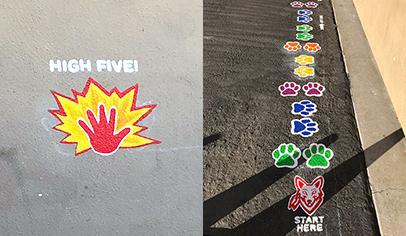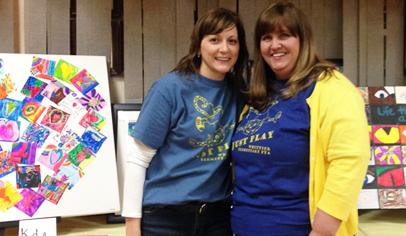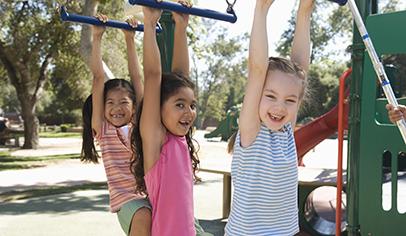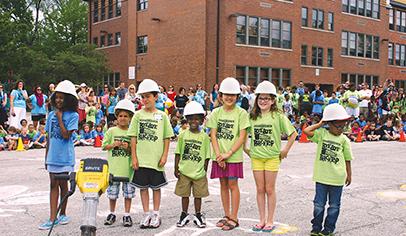From the mountains of New Hampshire to the California coast, parents are swinging hammers and digging postholes to build better places for their children to play.
Community-built playground projects, where volunteers instead of professionals install playground equipment, have grown in popularity as schools find they can complete playgrounds for one-half to one-third the cost of having equipment professionally installed. More important, parent groups find that by doing the work themselves they are not just building a playground but building community.
In Defiance, Ohio, it took 40 volunteers just one day last August to construct the $30,000 playground at the new Tinora Elementary School. The project provided families at the new school, which drew students from three different elementaries, the chance to form relationships and build school spirit. It was the third playground build Principal Eric Spiller had worked on.
“At the other two schools it brought the community together,” Spiller says. “With students coming from three elementary schools, we needed a way to get to know each other and start to develop a family feel.”
In Waconia, Minn., more than 2,000 volunteers pitched in over five days to build the massive $145,000 playground at Bayview Elementary School in May. The population of Waconia has grown rapidly in recent years, and the project provided a way for families to meet and for new residents to get involved in the community, says playground coordinator Jenni Tuttle. “People would say they could only come for a couple hours, then they would have so much fun they would stay all day,” Tuttle says.
Chris Meyer, president of Meyer Design, which led the Tinora Elementary project, compares the community-built playground process to a modern-day barn raising, equal parts work and social event. “There are few opportunities available in our culture to work together in a large group with a common purpose,” Meyer says. “It’s a way to get to know your neighbors.”
Getting Started
Carrying out a project can take as little as a month or more than a year, depending on the complexity of the playground design. Schools typically start by hiring a company to help them customize the playground to the site and to students’ preferences. After the company prepares the design and the budget, the school’s fundraising kicks into high gear.
“When they call us they typically don’t have two nickels to rub together,” says Kelli Magowan, vice president of Learning Structures, a community-built playground company in Strafford, N.H.
Companies guide groups through the nuts and bolts of the project, often providing guidebooks to help schools organize such tasks as fundraising, recruiting volunteers, obtaining materials, and supplying food and childcare.
The actual construction can take from a day to several weeks, depending on the size of the project and the complexity of the design. Playground companies provide construction supervisors to guide volunteers through the heavy lifting and to ensure the structures meet playground safety rules and accessibility guidelines. When the last beam is in place and all the pea gravel is spread, schools should have something more than a typical playground.
Can You Do It?
Thinking of taking the plunge? PTO leaders who have taken on community-built projects will tell you that it takes a lot of time and effort, but the benefits go beyond saving money.
“I get a huge sense of satisfaction every time I go there and play with my children,” says Carolyn Kirk, who coordinated a build at East Gloucester Elementary School in Gloucester, Mass., with her husband.
Although she’s had a successful career as a business consultant, Kirk says the playground project was the most fun and rewarding project she’s worked on. The school’s old playground equipment had been removed as part of a city sewer project, and the school did not have funds for new equipment. The PTO worked with the non-profit KaBOOM to raise money for the $50,000 project that gave children a much needed place to play.
Before you sign on to the community-built concept, gauge how much support parents and school staff will lend to the project. If your school does not have an established volunteer network or the administration is less than enthusiastic about the idea, you may want to hire professional installers instead.
If your parent group has the support to carry out a community build, determine early on how much time and effort your group is willing to commit to the project. Recruit leaders who are willing to stay on the project as long as it takes, which may be more than one school year. Then talk with playground companies that lead community-built projects to find out how much of the work they do and what responsibilities your group will have. (See Finding the Right Company)
Just as many parents get sticker shock when they start shopping for playground equipment, many are stunned by the amount of effort involved in community-built projects. It’s easy to be overwhelmed in the beginning, but playground consultants say the key is to involve many people in the project, designating a project coordinator and forming subcommittees early on. Playground committees typically have 20 to 30 members.
“Sometimes people can bug out at that phase,” Meyer says. “You have to have people in the pipeline to support the project and people willing to stay with it.”
When Tuttle became one of the general coordinators for the project at Bayview Elementary School, she had just given birth to a daughter. By the time the project was built this May, her daughter was a talkative toddler. She took a leave of absence from her job to work on the project full-time. “I knew it was going to be a lot of work, but I didn’t know it was going to be the focus of my life,” Tuttle says.
With a $145,000 price tag, Tuttle’s project was at least two or three times the size of a typical school playground build. Still, the level of work involved even on smaller projects can be intimidating. But keep in mind that companies can design a playground to fit your needs and your budget. And playground professionals say it takes only a few enthusiastic, committed individuals to get a project up and running.
“It’s really about getting people involved,” says Marc Leathers, president of Leathers & Associates, the Ithaca, N.Y.-based company that designed the Bayview Elementary project. “A school is the perfect environment, because it has a community built into it and you already have the base for the project right from the start.”
Building a Community
As soon as your school has leaders in place for the project, start reaching out to the community for help. Designate committee members to recruit volunteers and to solicit financial and in-kind donations from throughout the community.
In Groveton, N.H., project leaders for the Groveton Elementary School playground project wrote letters to businesses and foundations in the town of 1,300. The school received more than one-third of its $30,000 budget in donations from the city government, two local foundations, the United Way, and a Masonic lodge.
“I didn’t realize how many groups there were in a little town like Groveton that were willing to give to a good cause,” says project Co-chair Cindy Rainville.
In Gloucester, Mass., the PTO mailed letters to 700 area businesses soliciting donations. Ten parents made follow-up phone calls that resulted in donations from more than 100 businesses.
Whatever the size and complexity of your project, it’s a good idea to have skilled laborers on hand. Tinora Elementary asked parents skilled in a variety of trades to take lead roles in the build, including the architect of the new school building. The school also asked concrete and construction workers in the area to contribute time to the build.
“You need a certain percentage of people to be somewhat skilled, comfortable using a saw and power equipment, and people in the trades willing to volunteer their time,” says Tuttle, an architect who serves on the Parks and Planning Commission for a neighboring town.
At Discovery Parent-Child Preschool in San Jose, Calif., parents recruited help from a carpenters’ union and the San Jose Job Corps, according to coordinator Lillian Wong. They gathered all the help they could get for their large project, a $99,000 playground designed by Leathers & Associates that was built in five days in April.
Parents at the cooperative preschool are required to volunteer on a regular basis, but even with 90 dedicated families, the school needed a lot of outside help to build the playground, which includes an obstacle course, a mosaic-tiled water play area, and a tricycle garage. The project involved 779 volunteers who worked a total of 5,050 hours over five days and were served 1,500 meals donated by local eateries.
To get that help, two volunteer coordinators wrote letters, passed out brochures, and published notices in local newspapers. One volunteer coordinator went to San Jose State University with her son during rush week and handed out a stack of brochures to sorority and fraternity members.
Parents at Bayview Elementary in Waconia, Minn., reached out to the community when forming their playground committee. The committee included the mayor, business leaders, local artists, and the principal and PTO president from the other elementary school in town. The school named the new playground for a longtime Waconia police officer, and the project was honored by the Waconia Chamber of Commerce.
Now students have a playground with castles, a pirate ship, and a lighthouse right on Lake Waconia. The $145,000 playground is valued at three times that amount.
“We ended up with so much more than something to play on,” Tuttle says. “It’s a destination point for people who come to town.”
Extra Dividends
In Groveton, N.H., the community-built playground project paved the way for smoother relations among the school system and taxpayers. “Older people feel like anything that happens at the school is going to be more tax dollars,” says Cindy Rainville, who co-chaired the project for 18 months and was treasurer of the Groveton Elementary PTO last year.
Parents wanted a playground tailor-made to their space. They also wanted to pull the entire community together on the project.
By building the playground, the school saved about $15,000. Just $6,000 of the $31,000 project cost was taxpayer-funded, in the form of a contribution from the town government. She also found people in the community willing to contribute to a good cause. About one-third of the project was funded by donations from community groups, and businesses donated free tires and cement.
“You’re surprised how much people are willing to give–maybe not money but time and products,” Rainville says.
About 130 volunteers from the community turned out over three days to convert an asphalt slab into new play structures with a 30-foot-long zip line, balance beam, and tire swing. The school mascot, an eagle, is represented throughout. The design by Learning Structures also featured a state landmark, the Old Man of the Mountain rock formation, in a mural on a climbing wall.
“So many people were there from the town, and there was a lot of camaraderie,” Rainville says.
Groveton dedicated its playground to a woman who taught at the school for 20 years and had recently died. “Her husband is so touched that he goes and sits on one of the benches at the playground and just watches the kids,” Rainville says.
The positive experience on the build led Rainville’s committee co-chair, Lisa Hamilton, to reform a defunct committee to research the possibility of building a new school. The Progressive Community Planning Committee is also working to raise money for a new swimming pool and studying the idea of building a skate park in Groveton.
Kirk had such a good experience working with the school administration, city leaders, and local businesses in Gloucester that she has decided to run for a seat on the local school committee. The playground has become a favorite of neighborhood children and a place for residents to meet new neighbors.
“This playground wasn’t a one-time community-built project,” Kirk says. “Community building takes place there every day.”
Avoid These Common Problems
Anyone who has built a house or remodeled a kitchen knows how unexpected problems can delay construction projects. Playground consultants offer the following advice for avoiding common problems on community-built playground projects.
The most common problem on build day stems from bad scheduling. Keep work flowing smoothly by making sure enough volunteers are signed up for each shift. Avoid front-loading the schedule, having more than enough volunteers on one shift and not enough on the next. And make sure that when volunteers show up, you have work ready for them to do.
Find out what permits you’ll need, and allow adequate time in your schedule to obtain them. Some cities require building or zoning permits, and many regulate the removal of trees at construction sites.
Obtaining city permits was the most frustrating part of the process at Discovery Parent-Child Preschool in San Jose, Calif. An unhealthy tree on the lot needed to be removed prior to construction, but obtaining a tree removal permit from the city took months. And the school could not get the building permit until the tree removal permit had been received. Once the private school received the necessary permits, it had trouble obtaining insurance for the build.
In urban areas underground utilities can complicate builds. It’s a good idea to find out early on whether utility lines are buried where you want to build. If they are, the playground design may need to be modified to avoid the utilities.
Plan on raising more than the estimate provided by the playground company. Kim Bronson, co-chair of the Groveton Elementary project, suggests trying to raise at least $2,000 more than playground company tells you, as the companies use a statewide average of costs. Some items may cost more locally, and you may find that some expenses were not included in the initial estimate.
If your school is obtaining building materials, inventory equipment ahead of the build to make sure no pieces are missing.
Make contingency plans for bad weather. Have contact lists ready for each day of the build. If a surprise thunderstorm cuts a construction day short, don’t forget to contact restaurants or volunteers scheduled to bring food to the site later in the day.
When your group runs into problems, work through them together so they do not become obstacles, and don’t forget to celebrate your successes, says Lisa Davidson, manager of community partnerships and programs at KaBOOM. Remember that in addition to building a playground, a goal of the project is long-term investment of the community.
“Once communities learn the basic tools for community-build playgrounds, they can apply those tools to make other changes in their communities,” Davidson says.
Finding the Right Company
The community-built playground business has boomed over the last 10 years. Some companies specialize in large-scale projects that take hundreds of work hours to build, while others focus on smaller projects that can be tackled in a day. Research several companies to find out which company’s approach fits best with your school’s needs.
Find out what will be required of your group and what expertise the company will bring to the project, including child development and construction experts.
“Make sure it’s a good fit in terms of what is your expectation as a community group member of the level of work you will need to perform,” says Chris Meyer, president of Meyer Design in Akron, Ohio. “Some models are very community-intense and some are less so.”
Some companies supply building materials and tools, while others provide schools with a list of what is needed. Schools can save additional money on the project by securing donated material or discounts from lumber yards and hardware stores.
Talk to past clients of companies and visit a past playground project, if possible. Ask companies how many playgrounds they build each year and how many of those are community-built projects.
Companies also offer different degrees of customization. Find out whether your playground design will be one of a kind, or if key elements will be mixed and matched from a catalog.
An increasing number of playground equipment companies say they do community-built projects. Ask companies how long they have been offering the service, ask about their community-build model, and find out what kind of reputation they have in the industry.
“Anyone can do the design of a playground,” says Jenni Tuttle, who coordinated a build at Bayview Elementary School in Waconia, Minn. Her school selected a firm that had an established community-building process.
Find out whether companies are licensed to work in your state, and if they are aware of all federal, state, and local laws that will apply to construction.
Ask how the structures will be built. Find out what experts will be on hand to help with complex elements, and whether any premanufactured elements will be used to save time.
Be sure to ask about product warranties, and find out whether the company carries liability insurance in the case of faulty equipment. Don’t forget to check each company’s record with the Better Business Bureau.
“Even if the vendor comes highly recommended, I would solicit bids from at least two other companies,” says Carolyn Kirk, who coordinated a project at East Gloucester Elementary School in Gloucester, Mass. “We did this and came away knowing we had great equipment, a great price, and a build partner who would see us through to the completion of the project.”
The nonprofit Community Built Association provides information and referrals.














